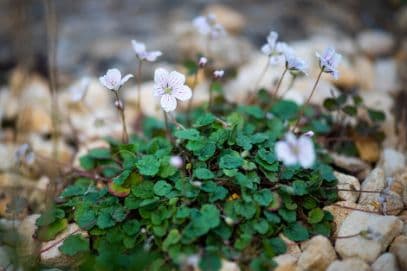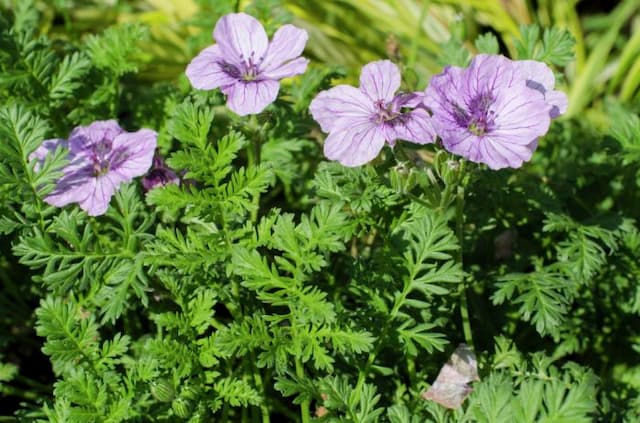Scented Geranium Pelargonium acetosum

ABOUT
Pelargonium acetosum, commonly known as the sour pelargonium, is a visually striking plant. The appearance of the sour pelargonium is quite distinctive with its succulent-like features. The leaves of this plant are generally heart-shaped or somewhat ivy-like in appearance but with a notable difference – they have a scalloped edge that gives them a unique silhouette. The leaf texture is somewhat fleshy, hinting at the plant's ability to retain moisture, and is typically a pale green color, sometimes with a hint of a silvery tone. Some leaves may show red or pinkish lines near the edges, adding to the decorative quality of the plant. The sour pelargonium blooms with small flowers that are typically grouped in clusters. These blossoms can add a pop of color to the overall greenish appearance of the foliage, with hues that range from a pale pink to a vibrant magenta. The flowers have a typical pelargonium structure, with upper petals differing in marking and size from the lower ones, often with streaks or spots. The sour pelargonium has a somewhat sprawling growth habit, giving it a relaxed and spreading appearance that can be quite eye-catching in a garden setting or when used as a potted plant. The overall texture and color palette of this plant make it a delightful addition to any plant collection, providing contrast against darker greens or complementing other succulents and Mediterranean-themed plantings. Despite its soft appearance, the sour pelargonium is known for its hardiness and adaptability to various growing conditions, although it thrives best in environments that mimic its native habitat.
About this plant
 Names
NamesSynonyms
Skeletal Pelargonium, Vine-leaved Pelargonium, Samphire-leaved Pelargonium.
Common names
Pelargonium acetosum.
 Toxicity
ToxicityTo humans
Pelargonium acetosum, commonly known as the Scented Geranium, is not typically considered toxic to humans. However, sensitivity can vary, and some individuals may experience mild irritation or an allergic reaction if they have sensitive skin or allergies. Ingesting large quantities of any plant could cause gastrointestinal discomfort, but Scented Geranium is generally not associated with serious toxicity or poisoning in humans when consumed in small amounts. Users should still exercise caution and keep plants out of reach of children who might ingest them out of curiosity.
To pets
Pelargonium acetosum, known as Scented Geranium, is considered non-toxic to pets, including cats and dogs, according to the American Society for the Prevention of Cruelty to Animals (ASPCA). However, eating plants is generally not recommended for pets, and ingestion can sometimes cause mild gastrointestinal upset such as vomiting or diarrhea. It is advisable to monitor your pets and prevent them from eating plants, as individual reactions can vary, and what might be non-toxic for one animal can cause problems for another if they are particularly sensitive or consume large quantities.
 Characteristics
CharacteristicsLife cycle
Perennials
Foliage type
Deciduous
Color of leaves
Green
Flower color
Pink
Height
2 feet (60 cm)
Spread
2 feet (60 cm)
Plant type
Shrub
Hardiness zones
10
Native area
South Africa
Benefits
 General Benefits
General Benefits- Ornamental Value: Pelargonium acetosum, also known as the sour fig, has a unique aesthetic with succulent leaves and colorful flowers that can enhance the visual appeal of gardens and landscapes.
- Drought Tolerance: As a succulent, sour fig is highly resilient to dry conditions, making it ideal for water-conservative gardening or regions with low rainfall.
- Low Maintenance: The plant requires minimal care once established, being able to cope with poor soil quality and infrequent watering.
- Soil Erosion Control: Its spreading habit and robust root system help stabilize the soil, preventing erosion in susceptible areas.
- Rapid Growth: Sour fig grows relatively quickly, providing ground cover and filling garden spaces in a short time frame.
- Edible Leaves: The leaves of Pelargonium acetosum can be used in salads or as a souring agent in cooking, providing a novel culinary ingredient.
- Wildlife Attraction: The flowers can attract pollinators like bees and butterflies, promoting biodiversity in the garden.
 Medical Properties
Medical Properties- Antioxidant activity: Pelargonium acetosum may contain compounds with antioxidant properties that can help in protecting cells from oxidative stress.
- Anti-inflammatory effects: Compounds in the plant might have the potential to reduce inflammation, which could be beneficial in treating conditions characterized by inflammation.
- Antimicrobial properties: Extracts from Pelargonium acetosum might have antimicrobial effects against certain bacteria and fungi.
 Air-purifying Qualities
Air-purifying QualitiesThis plant is not specifically known for air purifying qualities.
 Other Uses
Other Uses- Pelargonium acetosum, commonly known as sourgrass, can be used as an ornamental plant in dry gardens due to its succulent nature and tolerance to drought conditions.
- The leaves of sourgrass have a lemon-like flavor and can be incorporated in small quantities into salads or used as a garnish to add a tangy taste to dishes.
- Sourgrass can be grown as ground cover in areas with poor soil as it adapts well to less fertile conditions and helps control soil erosion.
- The sour-scented leaves of this plant can be used in potpourris and scented sachets to impart a fresh, citrusy aroma to linens and clothing.
- In some cultures, sourgrass is used as a natural insect repellent, where the crushed leaves are rubbed onto the skin to repel mosquitoes.
- Sourgrass can be used in the making of herbal teas, though rarely and carefully, as the strong-flavored leaves can complement or infuse unique flavors.
- The plant can be used as a companion plant in gardens to repel pests or attract beneficial insects that help in the pollination of other plants.
- Sourgrass stems may be used to create natural dyes for fabrics or paper, offering a range of colors from green to yellow hues.
- In some regions, the plant is used in traditional ceremonies or decorative motifs as its unique appearance and coloration can symbolize local folklore or heritage.
- The acidic nature of sourgrass leaves makes them suitable for use in small quantities as a natural cleaning agent for metals such as brass and copper.
Interesting Facts
 Feng Shui
Feng ShuiThe Pelargonium is not used in Feng Shui practice.
 Zodiac Sign Compitability
Zodiac Sign CompitabilityThe Pelargonium is not used in astrology practice.
 Plant Symbolism
Plant Symbolism- Resilience - Pelargonium acetosum, commonly known as Sour Fig, is a succulent plant that can thrive in harsh, dry environments, symbolizing the ability to endure and adapt to challenging conditions.
- Healing - The Sour Fig has been used in traditional medicine, particularly in its native South Africa, to treat various ailments such as digestive issues and wounds, representing healing and therapeutic properties.
 Water
WaterFor the Scented Geranium (Pelargonium acetosum), it's ideal to maintain a balance between moist and dry soil. Water this plant deeply but infrequently, allowing the top inch of the soil to dry out before watering again. Typically, watering once a week is sufficient, but this may vary depending on climate conditions and indoor environments. It's recommended to provide approximately one quart of water for potted plants during each watering session. Avoid overhead watering to prevent leaf and stem diseases, and reduce watering in the winter when plant growth slows down.
 Light
LightScented Geraniums prefer bright, indirect sunlight and will thrive in a location that receives plenty of light without being exposed to harsh midday sun. A spot near an east- or west-facing window can be optimal, offering ample light while protecting the plant from the intense direct rays of the south. Avoid placing the plant in full shade or dark corners, as this will hinder its growth and flowering potential.
 Temperature
TemperatureScented Geraniums are comfortable in a range of temperatures but prefer a consistent environment between 55°F and 75°F. They can tolerate a minimum temperature of around 50°F but should be protected from frost and freezing conditions. During the summer months, they can be placed outdoors as long as the temperature doesn't exceed 80°F for extended periods.
 Pruning
PruningPruning Scented Geraniums promotes bushier growth and prevents the plant from becoming leggy. It's best to prune in the spring or early summer, trimming back overgrown stems and removing any dead or yellowing leaves. Pruning can be done as needed throughout the growing season to maintain the plant's shape and encourage new growth.
 Cleaning
CleaningAs needed
 Soil
SoilThe best soil mix for the Sour Fig (Pelargonium acetosum) should be well-draining with a mix of potting soil, coarse sand, and peat. It prefers a soil pH between 6.0 and 8.0. Adding perlite can enhance drainage.
 Repotting
RepottingSour Fig should be repotted every two to three years to refresh soil and prevent becoming root-bound. Spring is the best time for repotting.
 Humidity & Misting
Humidity & MistingThe Sour Fig prefers moderate humidity levels but is quite adaptable and can tolerate lower humidity environments.
 Suitable locations
Suitable locationsIndoor
Place Sour Fig in bright light and well-draining soil.
Outdoor
Grow in sunny spot with well-drained soil and space.
Hardiness zone
9-11 USDA.
 Life cycle
Life cyclePelargonium acetosum, commonly known as the Scented Geranium, begins its life cycle when a seed germinates, usually in warm, moist soil conditions. Upon germination, a seedling emerges and develops true leaves, entering the vegetative stage where the plant focuses on growth. As it matures, the Scented Geranium develops a branched stem structure and foliage, during which time it may be propagated through cuttings. The plant then enters its reproductive phase, characterized by the development of flowers, which are typically pollinated by insects to produce seeds. After pollination, the plant sets seed within fruit capsules that, once mature, dehisce to release the seeds for dispersal. The Scented Geranium is a perennial species and may enter a period of dormancy in response to adverse weather conditions, regrowing when favorable conditions return.
 Propogation
PropogationPropogation time
Spring to Summer
Propogation: Pelargonium acetosum, commonly known as the Scented Geranium, is a plant that is often propagated through cuttings. This method is popular due to its ease and effectiveness. To propagate Scented Geranium by cuttings, ideally one should choose healthy, non-flowering stems and cut a length of about 4 to 6 inches (10 to 15 centimeters) using a sharp, clean knife or scissors. The lower leaves of the cutting are then removed, and the cut end may be dipped in rooting hormone to encourage root development. The cutting should then be placed in a well-draining soil mix, with the bottom half of the stem buried. It's important to keep the soil consistently moist, but not waterlogged, and to place the cuttings in a warm location with indirect light. Roots typically develop in a few weeks, after which the new Scented Geranium plants can be transplanted to their own pots or to a suitable location in the garden.




![Cranesbill [Blue Sunrise]](/_next/image?url=https%3A%2F%2Fplants-admin.emdemapps.com%2Fimages%2Fplants%2F%2Fimages%2F604b638d45948.png&w=640&q=75)




